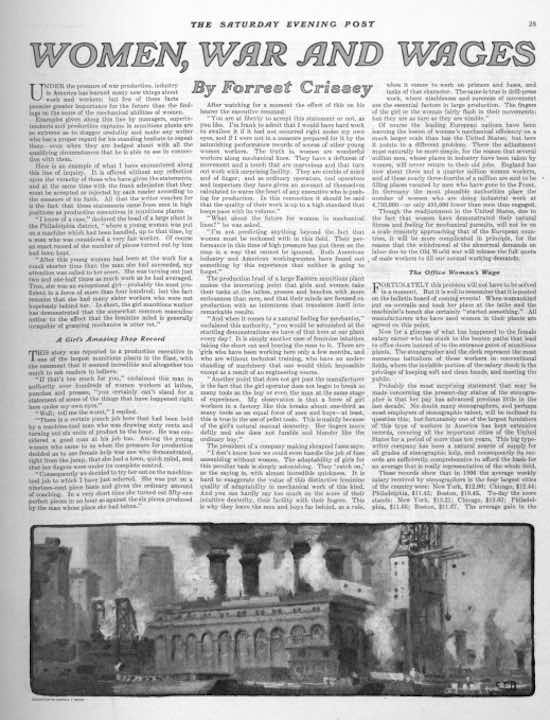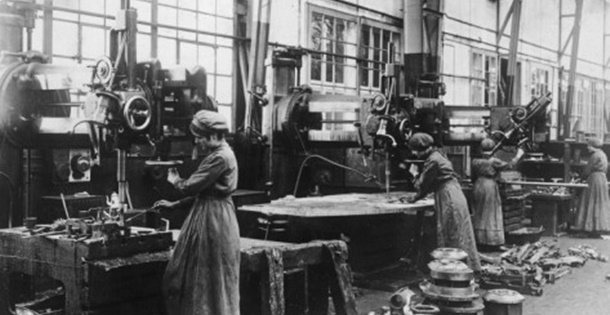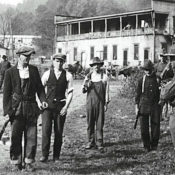In early 1917, America was still several months away from entering the Great War, but wartime production was already underway. In article from the January 20, 1917, issue of the Post, the author was astonished to find that, when women stepped into factory jobs normally done by men, they performed as well as the men, if not better. Even as he reported anecdotes from various factory managers, he cast doubt on the idea, noting that the claims “seemed incredible and altogether too much to ask readers to believe.”
“If that’s too much for you,” exclaimed this man in authority over hundreds of women workers at lathes, punches and presses, “you certainly can’t stand for a statement of some of the things that have happened right here under my own eyes.”
“Well; tell me the worst,” I replied.
The manager went on to tell the tale of a woman who could put out 51 pieces per hour to her male predecessor’s measly six. On top of that, he paid her only 19 cents an hour compared to the man’s 60 cents. (Women also broke fewer tools.)
The need for women in munitions plants created more demand for “typical” women’s jobs – stenographers and bookkeepers. Workers could be choosey, and wages began to rise; the average pay for a stenographer was $13 a week — 60 cents more than a decade earlier.
Demand was great enough that women could be assured that not even age was a detriment. An employment agent pointed out, “Do not think for a moment that gray hairs are a handicap to a woman applicant for a position of this class and character. If anything gray hairs count as a help.”
The article moves on to average wages for other workers of the era, including railroad station agents ($75/month), grocery clerks ($50/month), and bank executives ($200/month). But the larger issue of women entering the workforce – and perhaps staying – loomed large. As one manager observed, “Both American industry and American workingwomen have found out something by this experience that neither is going to forget.”

Become a Saturday Evening Post member and enjoy unlimited access. Subscribe now




Comments
Thank you Post Editors for reprinting this extremely fascinating article. I had to break it up into two evenings to read, but that’s fine; it was well worth it.
Sorry guys, but the women WERE better workers, producers, more reliable, handled the equipment better and more. The disparity of pay and positions for both men and women are discussed here at great length.
Unfortunately since about 1973, when the end of the post World War II economic boom for the middle class ended, there’s been a not so gradual return to these type of conditions, despite obvious, specific things unique to this time period.
The writing style of it was interesting to me. It still retained some 19th century aspects, though was clearly 20th. The word today spelled to-day I found curious, and the term gray hairs instead of older workers also.
Speaking of the 19th century, I have plenty of friends and co-workers who are all “so shocked, disappointed, upset and furious” that their son and daughters who’ve graduated from college & beyond (!) over the past 20 years or so are still unable to get more than minimum-wage jobs, let alone pay back the horrible student loans more than $25 a month.
This article didn’t get into that too much, but college IS rooted in the 19th century. Most are only there because they’re terrified of not being able to get a job, not because they care about “education”. Perhaps that’s the answer to the question if more people have college degrees today than ever before, why is this country on such a lowest common denominator, bottom feeder level now?!
No easy answer, but I highly recommend a one hour documentary from some years back called ‘The College Conspiracy’ right here online. Just put the name in, click and that’s it. I’ve watched it with some of the people I mentioned, and even those who were still VERY pro-college prior, no longer felt that away after viewing it.